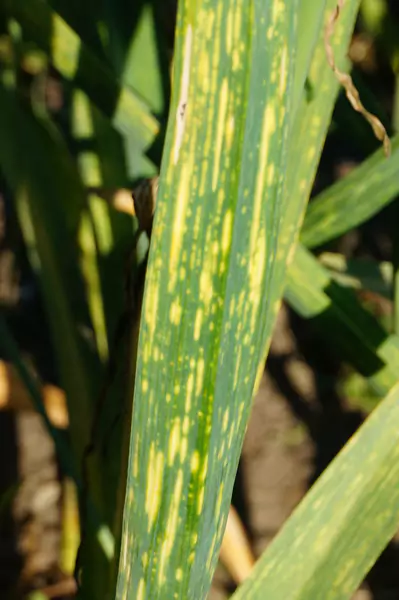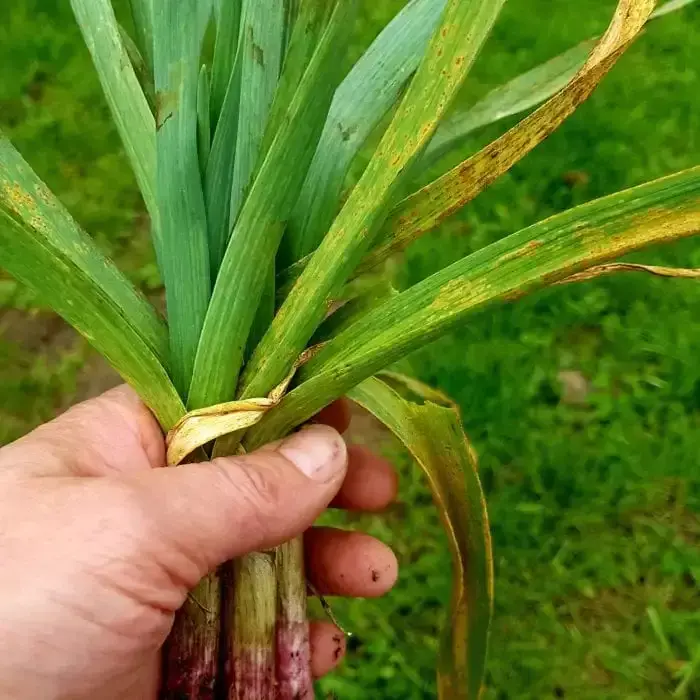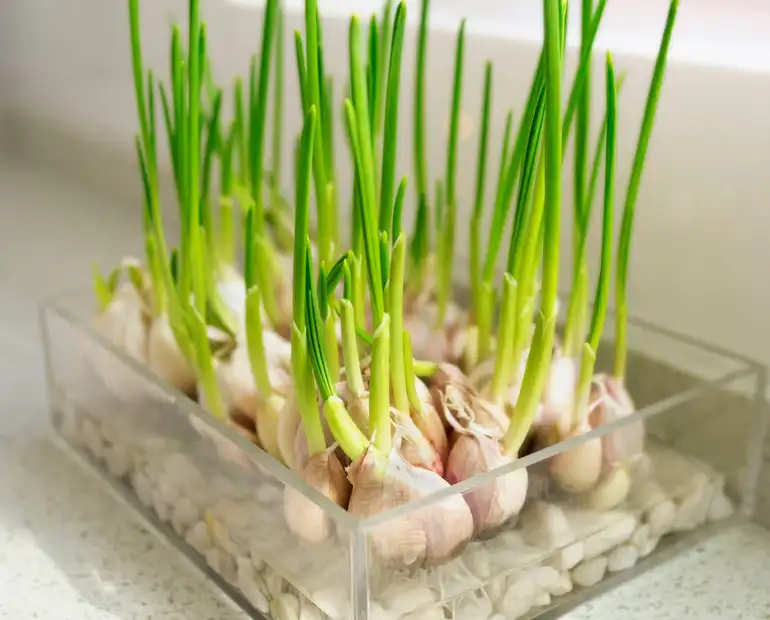Garlic as a Bi-Annual Crop and Causes of Yellowing Leaves
Garlic is a bi-annual crop, meaning it breaks dormancy twice a year.
- It is sown in winter, and during early winter, it breaks dormancy. However, as the cold intensifies, it becomes dormant again.
- When winter ends and spring approaches, garlic comes out of dormancy once more.
Initial Leaves and Temperature Fluctuations
The first emerging leaves are the oldest ones and act as test leaves. These leaves test the availability of water and nutrients to determine whether conditions are favorable. They remain under stress during this period as they experience wild temperature swings—for example, one day, the temperature is 28°C, the previous day, it was 10°C, and earlier, it was 30°C.
These temperature fluctuations—cool nights and warm days—put stress on the plant. Due to previous dormancy and the sudden transition, wear and tear occurs, causing the leaves to turn yellow. This issue resolves itself within two to three weeks.



لہسن ایک دو سالہ فصل ہے، یعنی یہ سال میں دو بار سستی کو توڑ دیتی ہے۔ اسے سردیوں میں بویا جاتا ہے، اور سردیوں کے شروع میں، یہ سستی کو توڑ دیتا ہے۔ تاہم، جیسے جیسے سردی کی شدت بڑھتی ہے، یہ دوبارہ غیر فعال ہو جاتا ہے۔ جب موسم سرما ختم ہوتا ہے اور موسم بہار قریب آتا ہے، لہسن ایک بار پھر سستی سے باہر آجاتا ہے۔ ابتدائی پتے اور درجہ حرارت کے اتار چڑھاؤ۔ پہلے ابھرنے والے پتے سب سے پرانے ہوتے ہیں اور آزمائشی پتے کے طور پر کام کرتے ہیں۔ یہ پتے پانی اور غذائی اجزاء کی دستیابی کو جانچتے ہیں تاکہ یہ معلوم کیا جا سکے کہ حالات سازگار ہیں یا نہیں۔ وہ اس عرصے کے دوران تناؤ میں رہتے ہیں کیونکہ وہ جنگلی درجہ حرارت کے جھولوں کا تجربہ کرتے ہیں — مثال کے طور پر، ایک دن، درجہ حرارت 28 ° C ہے، پچھلے دن، یہ 10 ° C تھا، اور اس سے پہلے، یہ 30 ° C تھا۔ درجہ حرارت کے یہ اتار چڑھاو — ٹھنڈی راتیں اور گرم دن — پودے پر دباؤ ڈالتے ہیں۔ سابقہ سستی اور اچانک منتقلی کی وجہ سے، ٹوٹ پھوٹ کا شکار ہو جاتے ہیں، جس سے پتے پیلے ہو جاتے ہیں۔ یہ مسئلہ دو سے تین ہفتوں میں خود ہی حل ہو جاتا ہے۔
Reasons for Garlic Leaves Turning Yellow
1. Early Sowing & Unsuitable Temperature
If garlic is sown too early, the temperature may not be suitable, causing the leaves to turn yellow.
2. Water Deficiency
Garlic is a spring crop, and Allium family plants prefer ample water.
- If there is insufficient water, the plant uses the available moisture for bulb formation, leading to leaf yellowing as it tries to conserve water.
- Conversely, excessive watering can also negatively impact the plant.
3. Nitrogen Deficiency
A lack of nitrogen can cause garlic leaves to turn yellow. Many believe phosphorus is essential for root crops, which is partially true, but garlic primarily forms a bulb rather than a deep root system.
- The outer skin of the bulb corresponds to the number of leaves—more leaves mean a larger bulb.
- To break dormancy, garlic requires a high nitrogen supply. Therefore, an adequate nitrogen application is needed:
- At sowing time
- When dormancy breaks again in spring
لہسن کے پتے پیلے ہونے کی وجوہات۔1۔ جلد بوائی اور غیر موزوں درجہ حرارت .اگر لہسن بہت جلد بویا جائے تو درجہ حرارت مناسب نہیں ہو سکتا جس کی وجہ سے پتے پیلے ہو جاتے ہیں۔2۔ پانی کی کمیلہسن ایک موسم بہار کی فصل ہے، اور ایلیم فیملی کے پودے وافر پانی کو ترجیح دیتے ہیں۔ اگر پانی ناکافی ہو تو، پودا بلب بنانے کے لیے دستیاب نمی کا استعمال کرتا ہے، جس کی وجہ سے پتے پیلے پڑ جاتے ہیں کیونکہ یہ پانی کو محفوظ کرنے کیکوشش کرتا ہے۔اس کے برعکس، ضرورت سے زیادہ پانی پلانے پر بھی منفی اثر ڈال سکتا ہے۔3. نائٹروجن کی کمی نائٹروجن کی کمی لہسن کے پتے پیلے ہونے کا سبب بن سکتی ہے۔ بہت سے لوگوں کا خیال ہے کہ فاسفورس جڑوں کی فصلوں کے لیے ضروری ہے، جو کہ جزوی طور پر درست ہے، لیکن لہسن بنیادی طور پر ایک گہرے جڑ کے نظام کے بجائے ایک بلب بناتا ہے۔ بلب کی بیرونی جلد پتوں کی تعداد کے مساوی ہوتی ہے — زیادہ پتوں کا مطلب ایک بڑا بلب ہوتا ہے۔ سستی کو توڑنے کے لیے لہسن کو زیادہ نائٹروجن کی فراہمی کی ضرورت ہوتی ہے۔ لہذا، مناسب نائٹروجن استعمال کی ضرورت ہے: بوائی کے وقت۔
4. Natural Yellowing at Maturity
If the leaves turn yellow in summer, it is a sign of harvest readiness.
- When four or more leaves turn completely yellow, it indicates that the crop is mature and ready for harvesting.
- This is a natural process and not a cause for concern.
5. Lack of Sunlight
Insufficient sunlight can also cause garlic leaves to develop small, round yellow spots.
- These spots range from 1% to 5% of the plant’s surface and do not turn the entire leaf yellow.
Conclusion
Leaf yellowing in garlic is a natural process that can occur due to various factors. Early-stage yellowing is not a reason for concern. Ensuring adequate nitrogen supply at the beginning of growth and in spring can help maintain healthy foliage and a larger bulb size.
اگر گرمیوں میں پتے پیلے ہو جائیں تو یہ فصل کی تیاری کی علامت ہے۔ جب چار یا اس سے زیادہ پتے مکمل طور پر پیلے ہو جائیں تو یہ اس بات کی نشاندہی کرتا ہے کہ فصل پختہ ہو چکی ہے اور کٹائی کے لیے تیار ہے۔یہ ایک فطری عمل ہے اور پریشانی کا باعث نہیں۔5. سورج کی روشنی کی کمیناکافی سورج کی روشنی بھی لہسن کی پتیوں پر چھوٹے، گول پیلے دھبے پیدا کرنے کا سبب بن سکتی ہے۔یہ دھبے پودے کی سطح کے 1% سے 5% تک ہوتے ہیں اور پورے پتے کو پیلا نہیں کرتے۔نتیجہ: لہسن میں پتوں کا پیلا ہونا ایک قدرتی عمل ہے جو مختلف عوامل کی وجہ سے ہو سکتا ہے۔ ابتدائی مرحلے میں پیلا ہونا تشویش کی وجہ نہیں ہے۔ نمو کے آغاز میں اور موسم بہار میں مناسب نائٹروجن کی فراہمی کو یقینی بنانا صحت مند پودوں اور بڑے بلب کے سائز کو برقرار رکھنے میں مدد کر سکتا ہے۔